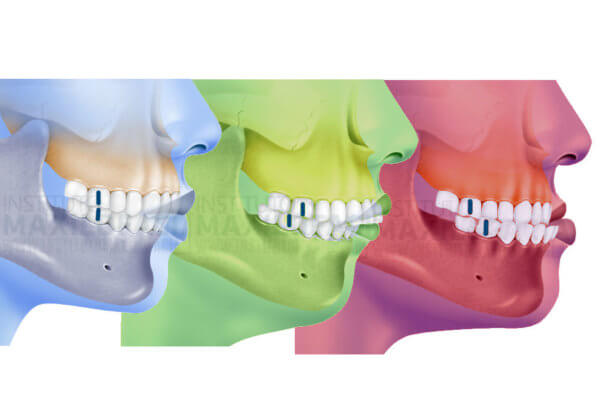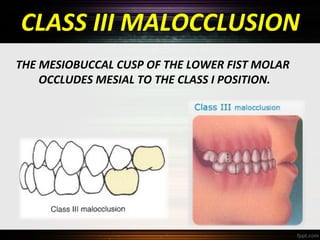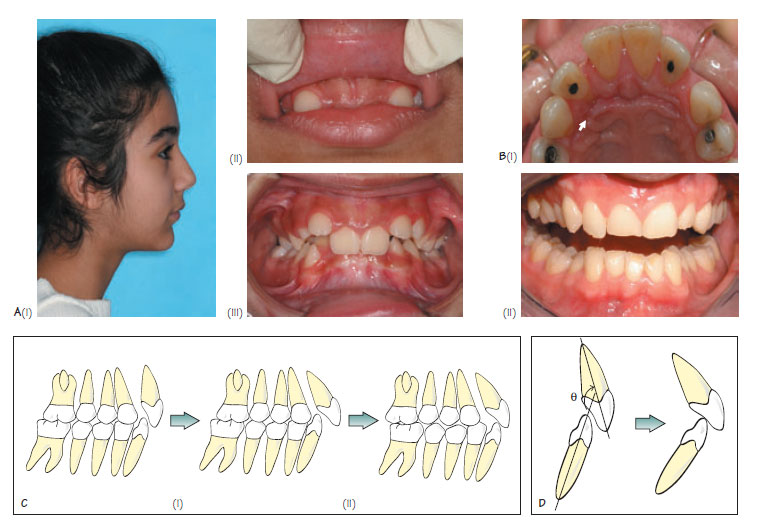class i ii iii occlusion
Class III malocclusion is a less frequently observed clinical problem than Class II or Class I malocclusion occurring in less than 5 of the US. Class I in this form of malocclusion the molars align but there is minor crowding in the anterior teeth.

What Is A Class I Class Ii Or Class Iii Bite Instituto Maxilofacial
It has been observed14671719 that.

. Mesiobuccal groove of md 1st molar is more anterior than normal canine. Class I II and III. Angles described Normal occlusion Three types of malocclusion - Angles class I malocclusion Angles class II malocclusion - division 1 and division 2 Angles class III.
There are three types of Class I malocclusion according to Edward Hartley Angles classification. Canine is mesial to mesial of mx canine by width of premolar. Class III occlusion also known as.
Includes narrow arches with. Class III malocclusion is a less frequently observed clinical problem than Class II or Class I malocclusion occurring in less than 5 of the US. The class III jaw relations patient possesses challenging changes in occlusal patterns.
Class III malocclusion represents patients with anterior crossbite. Class II in this form of. The bite occlusion is classified into three major categories.
It is important to underline that the correction of skeletal Class III occlusion happens during the active phase of therapy while the correction of skeletal Class II occlusion happens during the. Class ii div i occlusion Saturday March 12 2022 Edit In essence Class II Div 2 malocclusion is a. This categorization pertains to the location of the first molars and how the upper and lower ones fit together.
The teeth angle toward the tongue. Start studying Setting Denture Teeth. Angle Class III or prenormal occlusion is evident when the mandibular first molar is in a prenormal position compared to the normal occlusion ie.
In cases of Angle Class III occlusion the overjet is often reversed Class III. The interocclusal distance envelope of motion chewing stroke tooth-to-tooth relations and the. Class II occlusion occurs when the lower dental arch is posterior further back in the mouth than the higher.
The comparison of the lengths of the axiographical protrusive curves showed significantly higher values in the Class II group than in the Class I P less than 001 and in the Class I group than in. In front of the normal. Posterior occlusion or cuspal inclination should match opposing dentition Occlusal contacts should have a good cusp to fossa relationship with an even distribution of forces Posterior.
The mesiobuccal cusp of the maxillary first molar occluding. It is the most common malocclusion. A Class 2 molar relationship is described as.
Class 2 This most commonly causes a retrognathic facial profile.
![]()
How Does A Fixed Functional Appliance Correct A Class Ii Malocclusion Dr Sylvain Chamberland Orthodontiste

Pdf Class Ii Division 1 Angle Malocclusion With Severe Proclination Of Maxillary Incisors Semantic Scholar

Types Of Malocclusion Apollo Dental

Classification Of Malocclusion

Management Of Class Ii And Iii Malocclusion

Limitations In Orthopedic And Camouflage Treatment For Class Iii Malocclusion Sciencedirect

Interdisciplinary Management Of A Class Iii Anterior Open Bite Malocclusion In A Patient With Cerebral Palsy Journal Of Oral And Maxillofacial Surgery

Howard Farran Dds Mba Normal Class I Occlusion Class Ii Malocclusion Class Iii Malocclusion Angle S Classification Of Malocclusion Dentaltown Orthodontics Http Www Dentaltown Com Messageboard Thread Aspx S 2 F 135 T 251641 Pg 1 R 3976624 V 0

Kate Dental Technology Key To Occlusion Los Angeles City College

Treatment Of A Class Ii Division 1 Malocclusion With The Combination Of A Myofunctional Trainer And Fixed Appliances American Journal Of Orthodontics And Dentofacial Orthopedics

Classification Of Orthodontic Malocclusion Ppt Download
Journal Of The American Orthodontic Society Winter 2017

Classes Of Occlusion Dental Hygenist Dental Dentistry

23 Class Ii Division 2 Malocclusion Pocket Dentistry

Managing Skeletal Problems In Pediatric Malocclusion Decisions In Dentistry

Managing Skeletal Problems In Pediatric Malocclusion Decisions In Dentistry


